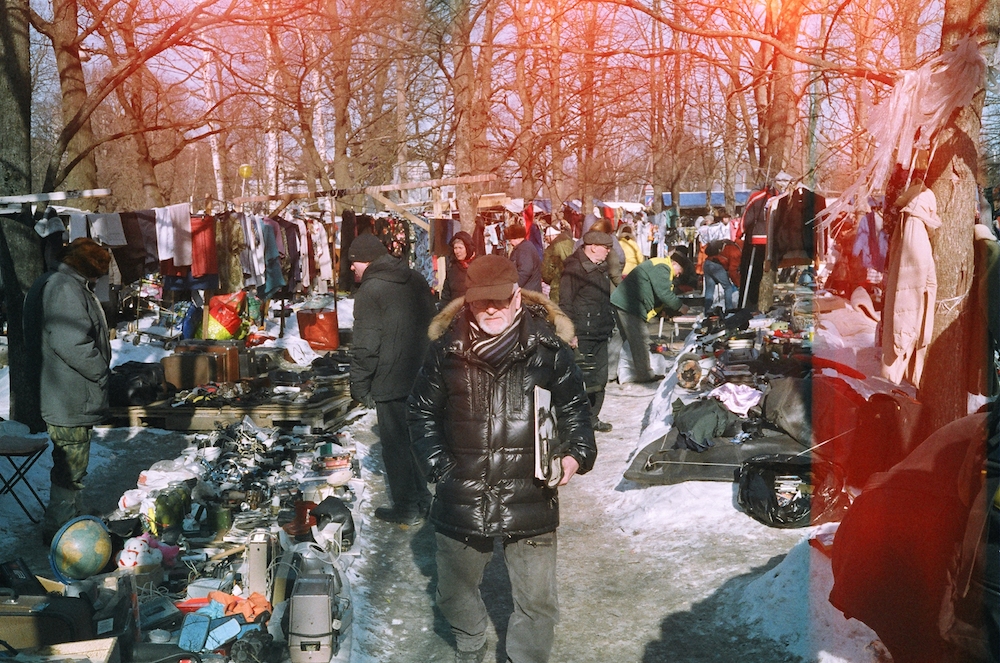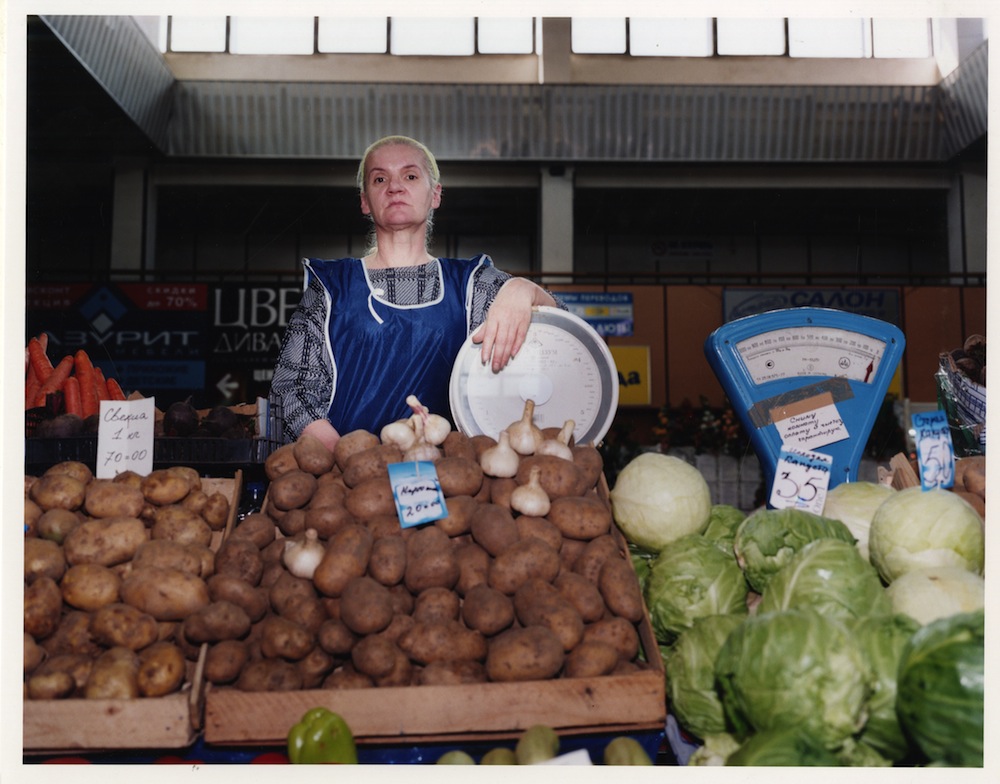Stalling careers: how a generation of Russian intellectuals became market traders

Budget cuts in the last days of the USSR forced many members of the intelligentsia — civil servants, engineers and doctors among them — to work on market stalls. Twenty-five years later, and many of them are still there
“You’re never short of good conversation here,” says Natalia, a vendor at Torzhok Sunday market. “That’s why I like working at the market — because there are a lot of intellectuals.” Natalia, the former head of a secondary school, now heads the market in the Tver region, roughly 300km north of Moscow. She is typical of those working there, many of whom were once civil servants, engineers, teachers, doctors, army officers or specialists in various Soviet enterprises, who lost their jobs in the late 1980s when a hefty cut in the state budget pushed people into other lines of work. Nor is Torzhok’s market different to those in other Russian towns. Over at the market in Satka, a town in the Southern Urals, the majority of hawkers are former workers from heavy industry, which collapsed following the dissolution of the USSR, as well as migrants from post-Soviet states.
Following the demise of the Soviet Union, unemployment meant that many of those working in the technical and scientific fields began new lives as market traders. Rough estimates indicate that by 1996, the main source of income for 41% of Russia’s economically active population, about 30 million people, was low-level trade.
Market and retail trade in Russia has always flourished during times of economic downturn. When the Civil War broke out in 1918, the meshochniki (suitcase salesmen) sprang into action. Likewise in the 1990s, when industrial production suffered a massive decline, the chelnochiki (import-export merchants) emerged and succeeded in setting up their own import-export businesses, thereby breaking the state monopoly on this kind of trade. It’s as if they’d all watched TV series which advised that in times of upheaval the public should “Drop everything! Buy goods and sell them for a profit!”
In Torzhok market, the number 15 kept being bandied around, mainly in relation to the number of years ago that traders started peddling their wares. Studying demographic patterns in the town reveals that 15 years ago, in the mid-1990s, Torzhok experienced its most significant population decline. It was then that most of its heavy industry closed down, while the remaining enterprises cut their workforce by over 50%. Unemployment forced many to seek alternative means of income. For years, residents lived in the hope that the economic crisis would end and that they would be able to return to their respective fields of expertise. Fifteen years later, and they’re still waiting.
A former teacher from Torzhok recalls that even after working extra hours she still could not solve her financial problems. “I normally bought 200g of pasta and two eggs. I’d prepare 100g of the pasta with one of the eggs in the evening to give to my son the next day. I’d finish anything he didn’t eat. The next day it was the same. I lost between eight and ten kilos. I had nothing to live on. In the end, I set up the first stall at this market. I was very ashamed. I kept on teaching but also selling at the market.”
The values of the Soviet intelligentsia do not sit well with the wheeler-dealer lifestyle
As members of the now obsolete Soviet techno-scientific intelligentsia, they view their new positions as an enforced step down, a lowering of their former social status. “For ten years I cried every morning when I left the house to go and sell footwear,” recalls the former head accountant of a factory. To this day her husband views working in the market as below him. Early each morning he helps her transport her goods to the market and erect her stall and then scarpers before the customers arrive. The values of the Soviet intelligentsia do not sit well with the wheeler-dealer lifestyle.
For a younger generation of small business owners, unburdened by memories of the Soviet past, it’s easier to adapt to the market environment. Unlike their elders, they do not suffer any crises in their worldview. The former heavy industry workers we met in Satka’s market rows found it equally easy to switch occupation. Their ability to use family connections to further commercial interests also set them apart from the “intelligentsia” traders of Torzhok. Traders in the Urals are much more likely to operate as whole families. Two or sometimes three generations can be involved in a single enterprise with a primitive division of labour. One person procures the goods, another takes care of transportation and a third mans the stall.
An examination of the type of sites where markets tend to spring up offers an insight into the cultural implications of such a large-scale socio-economic shift. In general, trading areas have surfaced in stadiums, parks, houses of culture, former factories, and bus and train stations. These public spaces have been adapted for trade because they offer some of the best transport connections as well as high footfall.
In the early 2000s, when certain industries began to pick up, municipal authorities thought they could banish flea markets from town centres. But the process of industrial regeneration occurred largely in big cities and Russia’s small towns are yet to recover from the financial crisis of the 1990s. Worse still, with an ever-growing number of Russians moving to cities, many smaller settlements risk losing their status as towns if populations drop below the required threshold of 50,000 people.
Russian markets are a symbol of financial crisis, a form of employment during straitened times
Satka and Torzhok belong to this category of towns at risk. Industry is not developing intensively enough and where it has been progressing, regeneration has involved advanced technologies that haven’t created new jobs. What’s more, weak consumer demand makes such towns unattractive to retail chains which means primitive forms of market trading are set to stay for a while yet. Meanwhile, in order to maintain an acceptable quality of life, the economically active population are either leaving town or taking to small-scale trade and business. Alternative social trajectories are available to few.
Unlike the traditional institution of the bazaar, as described by American anthropologist Clifford Geertz, Russian markets are rather a symbol of financial crisis, a form of employment during straitened times. The new social reality is also reflected in the way towns are now organised, with many former Soviet enterprises adapted for storage and market activity. In Torzhok, the Sunday market takes over the longest street in the town, closing it to all transport.
The market in Satka also occupies a central position atop a small hill that crowns the town’s main street, Solnechnaya Ulitsa. In contrast to Torzhok, Satka’s market is open daily. The offering at both is extremely varied: motorcycles, rugs, food and household cleaning products. Although there are barriers marking the official borders of the market, informal street trade spills out beyond them: in the central street, hawkers sell berries, potatoes and souvenirs. These informal stalls are manned by pensioners and people from nearby villages — in other words, the poorest inhabitants.
Traders are constantly trying to occupy new territories. The first floors of residential houses are being rebuilt and re-classified as commercial property. For a business owner, opening a shop in town presents new possibilities and is a symbol of a successful career. The shops in Torzhok and even several of the boutiques in the Tver region are the result of local business owners diversifying: the fact that they are opening salons or specialised outlets does not mean they are rushing to leave the bazaar. The boutiques on the central streets of the towns are in truth a continuation of the bazaar. They are about as traditional as the bazaar is modern.
The administrations of many small towns are no longer doing battle with criminals, but with the traders themselves
For more than 25 years, the municipal authorities of big and small towns have been trying to regulate markets and lead them out of the black and grey economic zones. In the 1990s, the markets were the birthplace of powerful criminal gangs that operated rackets. For example, the famous Uralmashevsky Group formed in the central market in Sverdlovsk. Nowadays organised crime has lost its control over retail trade but not because of the declared government crackdown. It’s more likely that major criminals have simply abandoned markets for more lucrative spheres.
So now, the administrations of many small towns are no longer doing battle with criminals, leeching off small-scale street trade, but with the traders themselves, combatting things like non-compliance with sanitary regulations and product standards. The local newspaper frequently report raids by police, trying for the umpteenth time to rid this or that bus station or park from street traders. These raids will continue until small towns such as Torzhok and Satka resolve their biggest problem: black market employment.
For Victoria, a former factory worker in Satka, leaving her job was not so difficult given that all aspects of life can be “equally hard”. “I’m not afraid of anything anymore. Would I be able to make it as a trader? What’s there to be afraid of?” she says. “We are already standing on our knees, so the worst that can happen is hitting the asphalt with your face. There is nothing scarier than death. As kids we were afraid of our parents when we were naughty, at work, of our bosses. I don’t want to be afraid anymore. I’ll stand up for myself and my family in any situation.”






.jpg)